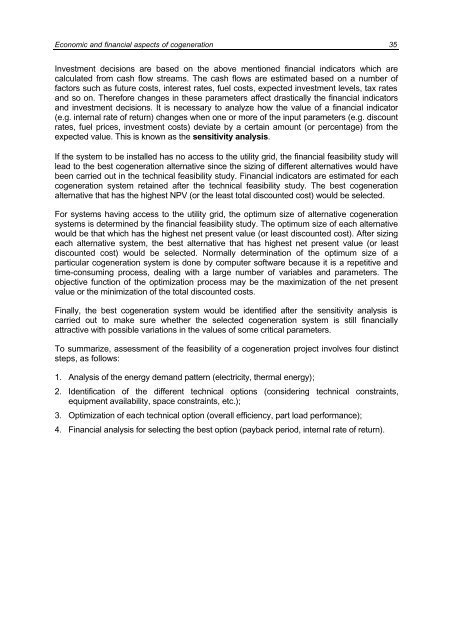part 1: overview of cogeneration and its status in asia - Fire
part 1: overview of cogeneration and its status in asia - Fire
part 1: overview of cogeneration and its status in asia - Fire
Create successful ePaper yourself
Turn your PDF publications into a flip-book with our unique Google optimized e-Paper software.
Economic <strong>and</strong> f<strong>in</strong>ancial aspects <strong>of</strong> <strong>cogeneration</strong> 35<br />
Investment decisions are based on the above mentioned f<strong>in</strong>ancial <strong>in</strong>dicators which are<br />
calculated from cash flow streams. The cash flows are estimated based on a number <strong>of</strong><br />
factors such as future costs, <strong>in</strong>terest rates, fuel costs, expected <strong>in</strong>vestment levels, tax rates<br />
<strong>and</strong> so on. Therefore changes <strong>in</strong> these parameters affect drastically the f<strong>in</strong>ancial <strong>in</strong>dicators<br />
<strong>and</strong> <strong>in</strong>vestment decisions. It is necessary to analyze how the value <strong>of</strong> a f<strong>in</strong>ancial <strong>in</strong>dicator<br />
(e.g. <strong>in</strong>ternal rate <strong>of</strong> return) changes when one or more <strong>of</strong> the <strong>in</strong>put parameters (e.g. discount<br />
rates, fuel prices, <strong>in</strong>vestment costs) deviate by a certa<strong>in</strong> amount (or percentage) from the<br />
expected value. This is known as the sensitivity analysis.<br />
If the system to be <strong>in</strong>stalled has no access to the utility grid, the f<strong>in</strong>ancial feasibility study will<br />
lead to the best <strong>cogeneration</strong> alternative s<strong>in</strong>ce the siz<strong>in</strong>g <strong>of</strong> different alternatives would have<br />
been carried out <strong>in</strong> the technical feasibility study. F<strong>in</strong>ancial <strong>in</strong>dicators are estimated for each<br />
<strong>cogeneration</strong> system reta<strong>in</strong>ed after the technical feasibility study. The best <strong>cogeneration</strong><br />
alternative that has the highest NPV (or the least total discounted cost) would be selected.<br />
For systems hav<strong>in</strong>g access to the utility grid, the optimum size <strong>of</strong> alternative <strong>cogeneration</strong><br />
systems is determ<strong>in</strong>ed by the f<strong>in</strong>ancial feasibility study. The optimum size <strong>of</strong> each alternative<br />
would be that which has the highest net present value (or least discounted cost). After siz<strong>in</strong>g<br />
each alternative system, the best alternative that has highest net present value (or least<br />
discounted cost) would be selected. Normally determ<strong>in</strong>ation <strong>of</strong> the optimum size <strong>of</strong> a<br />
<strong>part</strong>icular <strong>cogeneration</strong> system is done by computer s<strong>of</strong>tware because it is a repetitive <strong>and</strong><br />
time-consum<strong>in</strong>g process, deal<strong>in</strong>g with a large number <strong>of</strong> variables <strong>and</strong> parameters. The<br />
objective function <strong>of</strong> the optimization process may be the maximization <strong>of</strong> the net present<br />
value or the m<strong>in</strong>imization <strong>of</strong> the total discounted costs.<br />
F<strong>in</strong>ally, the best <strong>cogeneration</strong> system would be identified after the sensitivity analysis is<br />
carried out to make sure whether the selected <strong>cogeneration</strong> system is still f<strong>in</strong>ancially<br />
attractive with possible variations <strong>in</strong> the values <strong>of</strong> some critical parameters.<br />
To summarize, assessment <strong>of</strong> the feasibility <strong>of</strong> a <strong>cogeneration</strong> project <strong>in</strong>volves four dist<strong>in</strong>ct<br />
steps, as follows:<br />
1. Analysis <strong>of</strong> the energy dem<strong>and</strong> pattern (electricity, thermal energy);<br />
2. Identification <strong>of</strong> the different technical options (consider<strong>in</strong>g technical constra<strong>in</strong>ts,<br />
equipment availability, space constra<strong>in</strong>ts, etc.);<br />
3. Optimization <strong>of</strong> each technical option (overall efficiency, <strong>part</strong> load performance);<br />
4. F<strong>in</strong>ancial analysis for select<strong>in</strong>g the best option (payback period, <strong>in</strong>ternal rate <strong>of</strong> return).









